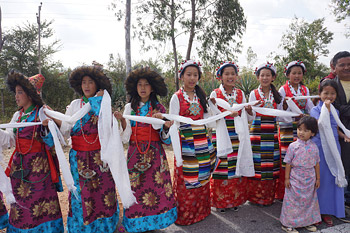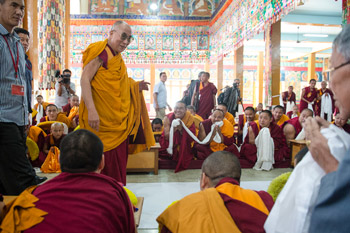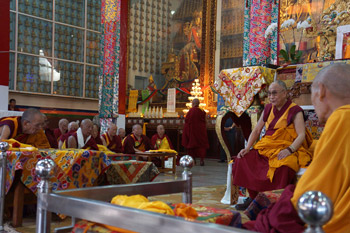Bylakuppe, Karnataka, India, 24 December 2013 - His Holiness the Dalai Lama set off from Bengaluru for Bylakuppe early this morning. Making good time, his party stopped for a break on the way at Mandya and before setting out again spoke to members of the press. He told them he was going to the Tibetan settlement at Bylakuppe to continue a set of Buddhist teachings he began last year. These teachings, the Stages of the Path to Enlightenment derive from instructions given in Tibet by the Indian master Dipankara Atisha. He expects upwards of 10,000 monastics to attend, as well as Tibetan and foreign lay people. He told the journalists that Tibetans remain hugely grateful to former Chief Minister of Mysore state, as it then was, Siddavanahalli Nijalingappa, who was instrumental in Tibetans being offered land on which they re-established themselves in agricultural communities. In addition to that, Tibetans have been able to re-establish several of the great monastic universities that are currently international centres of learning, attracting students from the Himalayan region, Mongolia, the Russian Mongolian Republics and other parts of Asia in addition to Tibetans.

|
Tibetans by the side of the road waiting for the arrival of His Holiness the Dalai Lama in the Tibetan settlement at Bylakuppe, Karnataka, India on December 24, 2013. Photo/Jeremy Russell/OHHDL
|
Arriving about midday at Sera Monastery, His Holiness was welcomed by the Ganden Tri Rinpoche, Jangtse and Sharpa Chojeys and the Sera Abbots. After paying his respects before the array of sacred images he took his seat before the throne. The Prayer for the Flourishing of the Dharma, an invocation to the 16 Arhats was recited while tea and sweet rice were distributed. His Holiness addressed the assembly:
“We’ve gathered here for the teaching of the Stages of the Path. My greetings to all of you, abbots, ex-abbots, monastic officials and others. Apparently 1000 foreigners have registered to come too. After this I’ll be visiting schools and universities near Bangalore and then going to Coimbatore to attend a ceremony concerning Swami Vivekananda. I’ll also visit a Hindu practitioner who has kept silent for 27 years, a practice that requires impressive mindfulness and determination. I tried to remain silent once for a week in retreat and often had the urge to speak.
“I’m pleased to see our monasteries here are still keeping their studies and practice in the traditional way. Bylakuppe is the oldest and one of the biggest settlements. Those of the older generation who set it up were not very educated, but they underwent great hardship to establish farms. The new generation at present have education and we need to see how we can improve and benefit from their skills. Settlement leaders today shouldn’t just follow what has been done before, they should consult the people to discover what’s needed and make changes where necessary. “
 |
| His Holiness the Dalai Lama greeting the gathering as he arrives at the Sera Lachi Temple at Sera Monastery in Bylakuppe, Karnataka, India on December 24, 2013. Photo/Tenzin Choejor/OHHDL |
He said that monastic institutions like this have engaged in study of the Buddha’s teachings as preserved in the Three Collections and the practice of the Three Higher Trainings. They have thereby preserved the scriptural and experiential tradition during very trying times.
“You have worked hard, but we should also remember those who made a great contribution here who have passed away. We’ll remember their kindness in setting up this settlement from generation to generation.
“We also have Tulkus, a tradition that began with the Karmapa and Samding Dorje Phagmo. They have long commanded great respect. As Je Tsongkhapa noted in his Great Treatise on the Stages of the Path a Lama should have qualities of learning, knowledge and the experience.”
From the Sera Lachi Temple, His Holiness travelled the short distance to Sera Mey Monastery, where he will be staying for the first week, after which he’ll go to stay in Sera Jey. The teachings will begin tomorrow on the Sera Jey courtyard.
“As I often say, I know you’ve had difficult times in Sera Mey and Ganden Shartse, but the majority of you monks made the right decision by applying your common sense and employing your intelligence. Once again I’d like to thank you. This issue is not somehow about me, but about preserving the path taught by Je Tsongkhapa, which is a complete path of method and wisdom. His writing and presentation were unique because he based them on the writings of Nagarjuna and his followers. They are thorough and inclusive. He wrote within the context of the general structure of Buddhism, not in relation to practice intended for some select individual.

|
His Holiness the Dalai Lama speaking at Sera Mey Monastery in Bylakuppe, Karnataka, India on December 24, 2013. Photo/Jeremy Russell/OHHDL
|
“There were monasteries where people said, ‘We’re really happy that His Holiness could visit but he’s accompanied by a demon.’ So we really need to preserve the pure tradition of Je Rinpoche that was praised by great scholars like Taktsang Lotsawa, who was critical in the beginning, but admiring in the end. Je Rinpoche’s view and his practice of Guhyasamaja, Chakrasamvara and Vajrabhairava were flawless, but the practice of Dolgyal spoils that tradition. It’s a flaw. Of course, for a time I did it too. But I realised my error and saw the truth of what the Fifth Dalai Lama had to say.
“We speak of the spiritual master, meditational deity and protector as being Manjushri, but Dolgyal is just a fierce mundane spirit, which is how Trijang Rinpoche used to refer to him. Trijang Rinpoche treated him like a servant not as an object of refuge.
“Of course, when it comes to the practice of the Dharma, you have a right to do what you want, but you shouldn’t be hypocritical about it, for example, telling me to my face that you don’t do it, but keeping it up behind my back. What’s more you won’t feel comfortable when faced with the Tibetan public. When I visited those who remain in Shartse they told me they belonged to the new Dokhang and I told them, ‘You are not the new ones, they are!”
His Holiness concluded by saying:
“Be happy and take courage from Je Rinpoche’s advice, “In the beginning I studied, the teachings dawned on me as instructions and I practised day and night.” This is what to do. 